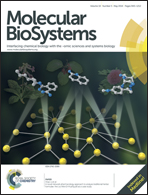Application of molecular docking and ONIOM methods for the description of interactions between anti-quorum sensing active (AHL) analogues and the Pseudomonas aeruginosa LasR binding site†
Abstract
Molecular docking methods were applied to simulate the coupling of a set of nineteen acyl homoserine lactone analogs into the binding site of the transcriptional receptor LasR. The best pose of each ligand was explored and a qualitative analysis of the possible interactions present in the complex was performed. From the results of the protein–ligand complex analysis, it was found that residues Tyr-64 and Tyr-47 are involved in important interactions, which mainly determine the antagonistic activity of the AHL analogues considered for this study. The effect of different substituents on the aromatic ring, the common structure to all ligands, was also evaluated focusing on how the interaction with the two previously mentioned tyrosine residues was affected. Electrostatic potential map calculations based on the electron density and the van der Waals radii were performed on all ligands to graphically aid in the explanation of the variation of charge density on their structures when the substituent on the aromatic ring is changed through the elements of the halogen group series. A quantitative approach was also considered and for that purpose the ONIOM method was performed to estimate the energy change in the different ligand–receptor complex regions. Those energy values were tested for their relationship with the corresponding IC50 in order to establish if there is any correlation between energy changes in the selected regions and the biological activity. The results obtained using the two approaches may contribute to the field of quorum sensing active molecules; the docking analysis revealed the role of some binding site residues involved in the formation of a halogen bridge with ligands. These interactions have been demonstrated to be responsible for the interruption of the signal propagation needed for the quorum sensing circuit. Using the other approach, the structure–activity relationship (SAR) analysis, it was possible to establish which structural characteristics and chemical requirements are necessary to classify a compound as a possible agonist or antagonist against the LasR binding site.


 Please wait while we load your content...
Please wait while we load your content...